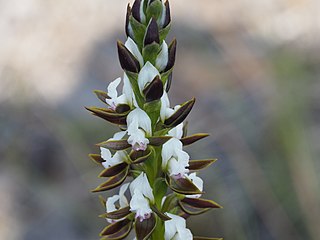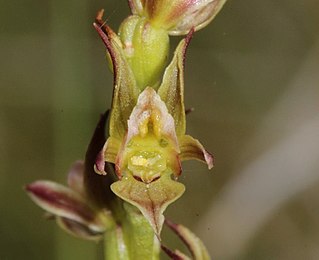
Prasophyllum sargentii, commonly known as the frilled leek orchid, is a species of orchid endemic to the south-west of Western Australia. It is a tall orchid with a single smooth, tubular leaf and up to thirty or more purplish and white or golden brown and white flowers with a frilled labellum.
Prasophyllum amoenum, commonly known as the dainty leek orchid or Snug leek orchid, is a species of orchid endemic to Tasmania. It has a single tubular, green leaf with a purplish base and between five and twelve light green, dark brown and white flowers. In 2007, the entire population was estimated to be about 600 plants.
Prasophyllum apoxychilum, commonly known as the tapered leek orchid, is a species of orchid endemic to Tasmania. It has a single tubular, green leaf with a purplish base and up to twenty light green and whitish flowers. It is very similar to P. truncatum, and there is some doubt as to whether the two species are distinct. The species is known from twenty widely separated populations and is usually only seen in disturbed sites, such as after fire.
Prasophyllum crebriflorum, commonly known as the crowded leek orchid, is a species of orchid endemic to Tasmania. It has a single tubular, dark green leaf with a purplish base and up to twenty five reddish-brown flowers. It is only known from four relatively small populations growing at high altitudes.
Prasophyllum brevilabre, commonly known as the Gorae leek orchid, is a species of orchid endemic to south-western Victoria. It has a single tubular, green leaf and up to forty greenish-brown flowers with reddish markings. It is a very rare orchid, now only known from two small, scattered populations. It was first recorded from Gorae West near Portland but is no longer found there.

Prasophyllum frenchii, commonly known as the maroon leek orchid or swamp leek orchid, is a species of orchid endemic to south-eastern continental Australia. It has a single tubular green leaf and up to sixty five green, reddish-brown or red flowers. Formerly more widespread, it is now confined to seven populations containing a total of fewer than 1,000 plants.
Prasophyllum hectori, commonly known as the swamp leek orchid, is a species of orchid endemic to New Zealand. It has a single tubular, dark green leaf and up to eighty scented, yellow-green flowers with red or brown marking. It is similar to P. colensoi, the only other species of Prasophyllum found in New Zealand, but is distinguished from it by its larger size, larger number of flowers and swampy habitat.
Prasophyllum incorrectum, commonly known as the golfer's leek orchid, is a species of orchid endemic to Tasmania. It has a single tubular, dark green leaf and up to twenty scented, yellowish-green and reddish-brown flowers. The largest population occurs on a golf course.
Prasophyllum incurvum is a species of orchid endemic to Tasmania. It has a single tubular, bright green leaf and up to forty brownish-green, white and purplish flowers. It is similar to P. alpestre but has larger flowers and petals which curve forwards.
Prasophyllum limnetes, commonly known as the marsh leek orchid, is a species of orchid endemic to Tasmania. It has a single tubular, green leaf and up to thirty five greenish-white flowers with a pinkish labellum. It is only known from a population of fewer than twenty plants growing in a sanctuary near Port Sorell.
Prasophyllum milfordense is a species of orchid endemic to Tasmania. It has a single tubular, dark green leaf and up to thirty greenish-brown, white and purplish flowers. It is a very rare orchid, only found in a single location with a population of around 240 plants.
Prasophyllum morganii, commonly known as the Cobungra leek orchid, is a species of orchid endemic to a small area in Victoria. It has a single tubular leaf and up to eighty greenish flowers with purplish markings. It was known from a single population of fifteen plants but has not been seen since 1933 and is now presumed extinct.
Prasophyllum olidum, commonly known as the pungent leek orchid is a species of orchid endemic to Tasmania. It has a single tubular, green to yellowish-green leaf and up to thirty bright green to brownish-green flowers. It is a very rare orchid, only found in a single location with a population which fluctuates from three to two hundred flowering plants.
Prasophyllum pallidum, commonly known as the pale leek orchid, is a species of orchid endemic to a south-eastern South Australia. It has a single tubular leaf and up to thirty green or yellowish-green flowers. It was previously thought to occur in Victoria but records from that state are now recognised as P. roseum.
Prasophyllum perangustum, commonly known as the Knocklofty leek orchid, is a species of orchid endemic to Tasmania. It has a single tubular, dark green leaf and up to fifteen greenish or light brown flowers with a white labellum. It is a very rare orchid with only six plants recorded in 1993.
Prasophyllum pulchellum, commonly known as the pretty leek orchid, is a species of orchid endemic to Tasmania. It has a single tubular, green leaf and up to twelve light reddish-brown flowers with a cream-coloured to whitish labellum. It is widely distributed in Tasmania and only about 130 plants are known but it is difficult to locate in the low heath where it grows and more individuals may survive.
Prasophyllum robustum, commonly known as the robust leek orchid, is a species of orchid endemic to Tasmania. It has a single tubular, green leaf and up to thirty greenish-brown flowers with a white labellum. It is only known from a single population of about fifty plants, its numbers having been reduced by land clearing.
Prasophyllum truncatum, commonly known as the truncate leek orchid, is a species of orchid endemic to Tasmania. It has a single tubular, dark green leaf and up to twenty whitish flowers with purplish and greenish-brown markings. It is a late-flowering leek orchid and its flowering is stimulated by earlier fire.

Prasophyllum tunbridgense, commonly known as the Tunbridge leek orchid, is a species of orchid endemic to Tasmania. It has a single tubular, bright green leaf and up to twenty five relatively large, green to light greenish-brown flowers with white petals and a large white labellum.
Prasophyllum abblittiorum is a species of orchid endemic to Tasmania. It has a single tubular, green leaf and up to twelve yellowish green flowers with faint streaks. It is an unusual prasophyllum in that the labellum is not ornamented. Only about 100 plants are known, growing at two sites in the Arthur-Pieman Conservation Area.








